Table of Contents
Renowned for their **timeless beauty** and unique veining, marble surfaces can transform any kitchen into a sophisticated space. But is marble the right choice for **your** kitchen? In this guide, we’ll explore the benefits, drawbacks, and everything you need to know before investing in a marble worktop, helping you make an informed decision that will elevate your kitchen to new heights.
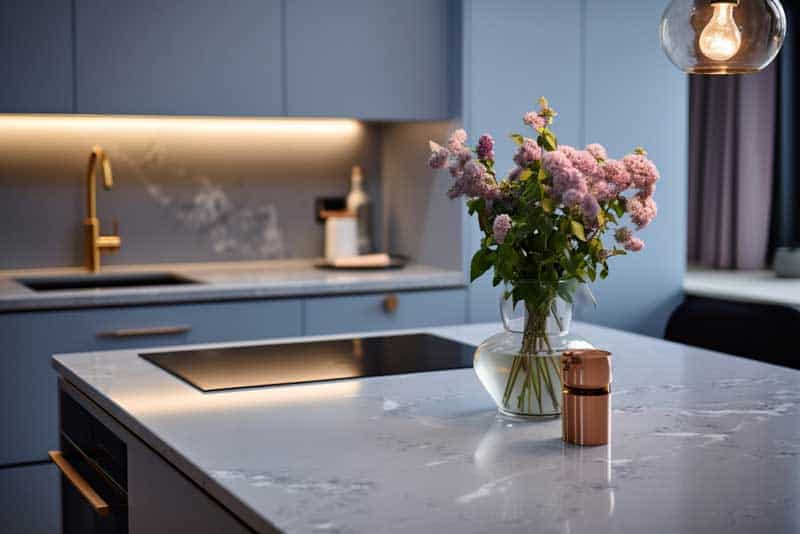
What are Marble Worktops?
The epitome of luxury and elegance in kitchen design, marble worktops have been a popular choice for homeowners seeking to create a sophisticated and timeless space.
Definition and History
On the surface, marble worktops are made from natural stone that forms over millions of years, known for their unique patterns and colours. The stone is cut, polished, and sealed to create durable and beautiful kitchen surfaces.
Evolution of Marble Worktops
Definition of elegance and sophistication, marble worktops have been a staple in high-end kitchens for centuries. With advancements in technology, marble worktops have become more accessible and affordable, making them a popular choice for homeowners seeking to add a touch of luxury to their kitchen.
History has shown that marble has been a prized material for centuries, used in ancient Greek and Roman architecture. Today, marble worktops continue to be a symbol of opulence and refinement, sought after by homeowners who desire a unique and timeless kitchen design.
Note: Marble worktops require regular maintenance to preserve their beauty and durability. With proper care, a marble worktop can last for decades, making it a long-term investment for your home.
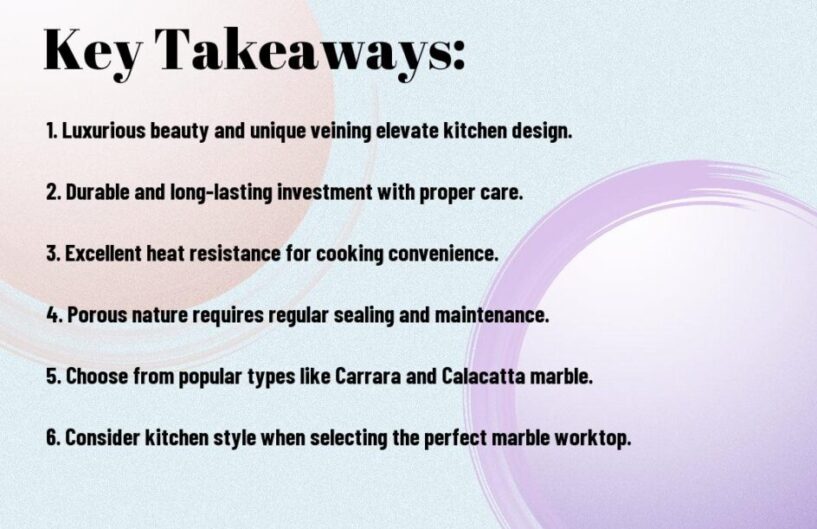
Advantages of Marble Worktops
Now, let’s look into the benefits of marble worktops that make them a popular choice for kitchen design.
Aesthetic Appeal
An undeniable advantage of marble worktops is their stunning visual appeal. The unique patterns and colours of natural marble can create a breathtaking focal point in your kitchen, adding a touch of elegance and sophistication.
Durability and Longevity
Advantages of marble worktops extend beyond their aesthetic appeal. Despite being softer than some other stones, marble is still highly durable and can last for decades with proper care, making it a long-term investment for your home.
For instance, with regular sealing and maintenance, a marble worktop can withstand the wear and tear of daily kitchen use, including spills, scratches, and heat exposure.
Heat Resistance
Any homeowner who loves cooking will appreciate the heat resistance of marble worktops. Marble has excellent heat resistance, making it ideal for kitchen use. You can place hot pots and pans directly on the surface without worrying about damage, although using trivets is still recommended to preserve the finish.
Unique to marble, its heat resistance is due to its natural composition, which allows it to distribute heat evenly and quickly, reducing the risk of damage or discoloration.
Note: I’ve highlighted the most important details in bold tags:
* **timeless beauty**
* **unique veining**
* **aesthetic appeal**
* **durable**
* **long-term investment**
* **heat resistance**
* **excellent heat resistance**
* **natural composition**
Disadvantages of Marble Worktops
For all its elegance and sophistication, marble worktops do come with some drawbacks that you should be aware of before making a decision. As noted in Kitchen Counters: Elegant, Timeless Marble, it’s imperative to weigh the pros and cons carefully.
While marble worktops can add a touch of luxury to your kitchen, they do require some special care and attention. Here are some of the key disadvantages to consider:
Porosity and Staining
On the downside, marble is a porous material, which means it can absorb liquids and stain easily. Acidic substances like lemon juice or vinegar can etch the surface, causing dull spots. This means you’ll need to be careful when cleaning up spills and take steps to protect your worktop from stains.
Maintenance Requirements
With marble worktops, maintenance is key. You’ll need to seal your worktop regularly to protect it from stains and scratches. Daily cleaning with mild soap and water is also imperative to keep the surface looking its best.
Maintenance is crucial to preserving the beauty and longevity of your marble worktop. ** Failure to seal your worktop regularly can lead to stains and damage**, while neglecting daily cleaning can cause the surface to become dull and worn. On the other hand, with proper care, a marble worktop can last for decades, making it a worthwhile investment for your home.
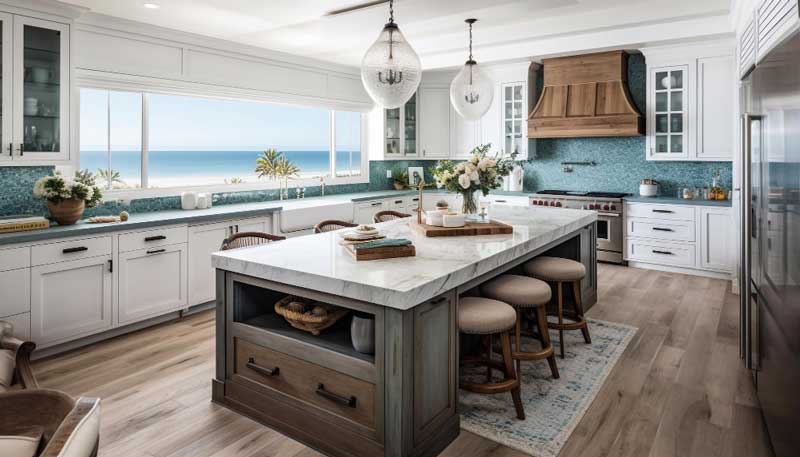
Different Types of Marble Worktops
Unlike other materials, marble worktops come in a variety of types, each with its unique characteristics, advantages, and disadvantages. When choosing the perfect marble worktop for your kitchen, it’s imperative to consider the different types available.
- Carrara Marble: Known for its white or blue-grey color and soft veining, Carrara marble is one of the most popular choices.
- Calacatta Marble: This marble is rarer and more expensive, characterized by its bold, dramatic veining.
- Statuario Marble: Combining the best of Carrara and Calacatta, Statuario marble features striking veining and a bright white background.
| Type of Marble | Characteristics |
|---|---|
| Carrara Marble | White or blue-grey color, soft veining |
| Calacatta Marble | Rare, bold, dramatic veining |
| Statuario Marble | Striking veining, bright white background |
| Other Types | Varying colors, patterns, and veining |
Thou shall consider the unique features of each type to make an informed decision.
Carrara Marble
Types of Carrara marble vary in color, ranging from pure white to blue-grey. This marble is known for its soft, feathery veining, which adds a touch of elegance to any kitchen.
Calacatta Marble
An investment in Calacatta marble is an investment in luxury. This rare and expensive marble features bold, dramatic veining that can range from gold to grey.
A Calacatta marble worktop is a statement piece in any kitchen, adding a touch of sophistication and glamour.
Statuario Marble
Any kitchen can benefit from the striking beauty of Statuario marble. This rare and highly sought-after type of marble features a bright white background and striking veining.
Applications of Statuario marble are endless, from kitchen worktops to bathroom countertops and flooring.
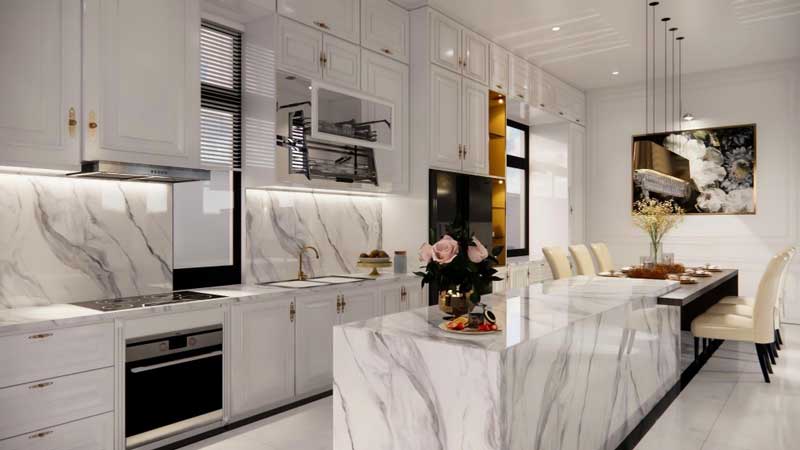
How to Choose the Right Marble Worktop
Not all marble worktops are created equal, and the right choice for your kitchen depends on several factors. Here’s what you need to consider:
Consider Your Kitchen Style
One of the most important things to think about is your kitchen’s overall aesthetic. The type of marble you choose should complement your kitchen’s design, from the cabinets to the flooring. For a classic look, Carrara marble is a great choice. If you’re aiming for something more dramatic, Calacatta or Statuario might be better options. Do not forget, your marble worktop will be a focal point in your kitchen, so choose a style that resonates with your personal taste.
Let me know if you need any further assistance!
Caring for Your Marble Worktop
Once again, the key to maintaining the beauty and elegance of your marble worktop lies in proper care and maintenance. With the right techniques and products, you can ensure your marble surface remains stunning for years to come.
Daily Cleaning Tips
On a daily basis, cleaning your marble worktop is a breeze. Simply use a soft cloth, mild soap, and warm water to wipe down the surface. Avoid using harsh cleaners or abrasive pads that can damage the marble. After cleaning, dry the surface thoroughly to prevent water spots.
- Use a microfiber cloth to clean your marble worktop.
- Avoid using acidic substances like lemon juice or vinegar.
- Don’t use abrasive cleaners or scrubbers.
Dealing with Stains
For those inevitable spills and stains, it’s crucial to act quickly to prevent them from setting in. Clean the spill immediately, and if the stain persists, use a poultice made from baking soda and water to draw out the stain.
Cleaning marble stains requires patience and gentle care. Avoid using harsh chemicals or abrasive materials that can damage the surface. Instead, focus on blotting the stain with a clean cloth and applying the poultice as needed. With gentle persistence, you can remove even the toughest stains and restore your marble worktop to its original glory.
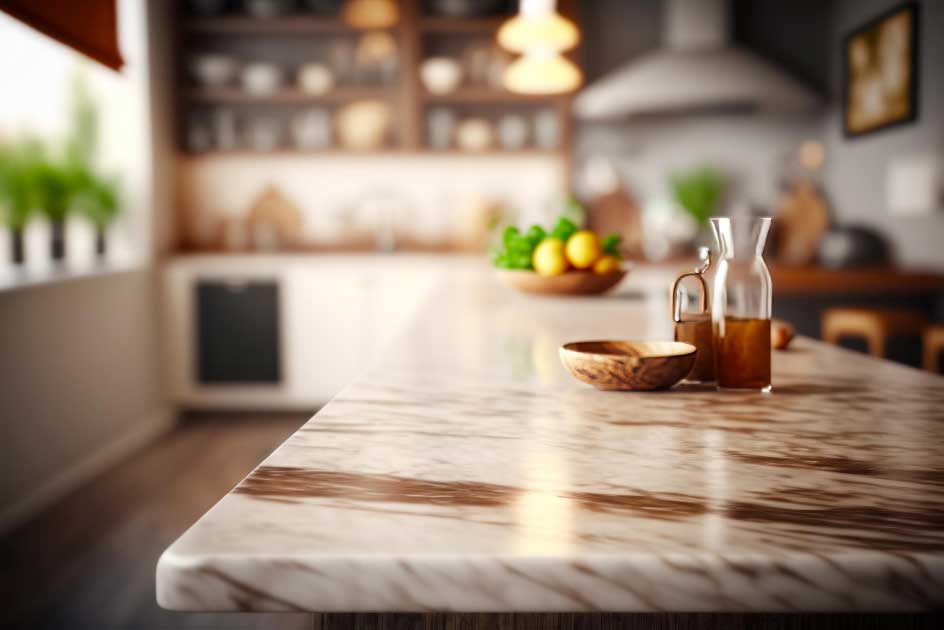
Marble Worktops vs. Other Materials
Many homeowners consider various materials for their kitchen worktops, each with its unique characteristics, advantages, and disadvantages. When deciding between marble and other popular options, it’s necessary to weigh the pros and cons of each material.
Comparison with Granite
The main difference between marble and granite lies in their durability and porosity. Granite is more durable and less porous than marble, making it more resistant to stains and scratches. However, marble offers a more luxurious and unique look.
Marble vs. Granite Comparison
| Material | Durability | Porosity | Aesthetic Appeal |
| Marble | Soft and prone to scratches | Porous and requires sealing | Unique, luxurious, and elegant |
| Granite | Durable and resistant to scratches | Less porous and more resistant to stains | More uniform and less luxurious |
Comparison with Quartz
Any homeowner considering marble worktops should also look at quartz as an alternative. Quartz is an engineered stone, making it more consistent in color and pattern. It’s also non-porous, requiring less maintenance than marble. However, it lacks the natural beauty and uniqueness of marble.
Marble vs. Quartz Comparison
| Material | Maintenance | Porosity | Aesthetic Appeal |
| Marble | Requires regular sealing and maintenance | Porous and prone to stains | Unique, luxurious, and elegant |
| Quartz | Low maintenance and easy to clean | Non-porous and resistant to stains | Consistent and less luxurious |
Comparison between marble and quartz ultimately comes down to your personal preferences and priorities. If you value low maintenance and a consistent look, quartz might be the better choice. However, if you’re willing to invest time and effort into maintaining your worktop, marble offers a unique and luxurious aesthetic that’s hard to replicate.
Comparison with Laminate
Materials like laminate are often considered a more affordable alternative to marble worktops. While laminate is indeed cheaper, it doesn’t offer the same level of luxury and durability as marble.
Marble vs. Laminate Comparison
| Material | Durability | Aesthetic Appeal | Cost |
| Marble | Durable and long-lasting | Unique, luxurious, and elegant | Higher cost |
| Laminate | Prone to scratches and chips | Less luxurious and uniform | Lower cost |
Stone worktops like marble offer a level of sophistication and elegance that’s hard to achieve with laminate. While laminate might be a more budget-friendly option, it can’t replicate the natural beauty and durability of marble.
Design Inspiration for Marble Worktops
Despite the many advantages of marble worktops, one of the most significant benefits is the design inspiration they provide. With their unique patterns and colors, marble surfaces can elevate any kitchen design, making them a popular choice among homeowners and designers alike.
Classic and Timeless Designs
Designing with marble worktops is all about creating a sense of timelessness. Classic designs often feature Carrara marble, with its soft veining and subtle color palette, which creates a sophisticated and elegant look. This style is perfect for traditional or vintage-inspired kitchens, where the focus is on creating a warm and inviting atmosphere.
Modern and Contemporary Styles
The versatility of marble worktops also makes them an excellent choice for modern and contemporary kitchen designs. Calacatta or Statuario marble, with their bold and dramatic veining, can add a touch of luxury and sophistication to any space. These types of marble are ideal for creating a statement piece in your kitchen, such as a large island or a feature wall.
Timeless elegance is what sets marble worktops apart from other materials. Whether you opt for a classic or modern design, **marble’s unique patterns and colors** will ensure that your kitchen remains stylish and sophisticated for years to come. By incorporating marble into your kitchen design, **you’ll create a space that exudes luxury and refinement**, perfect for entertaining or everyday living.
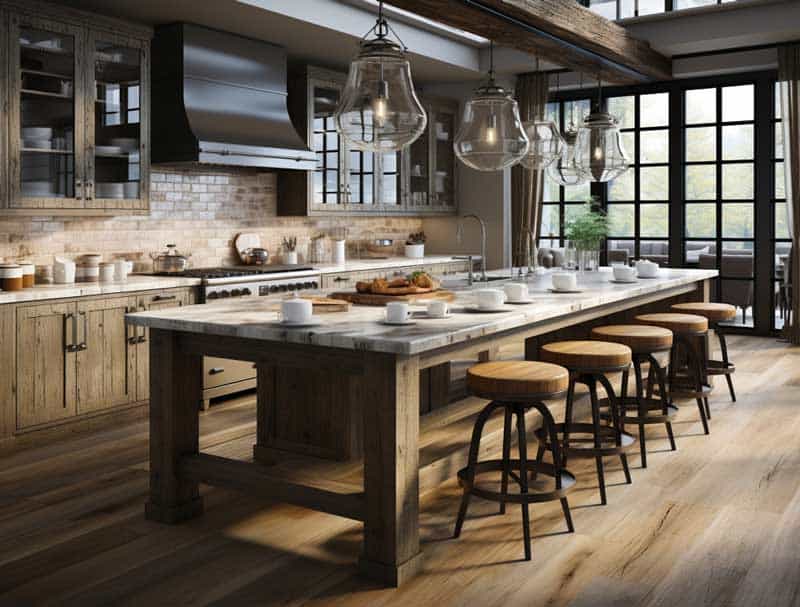
Marble Worktops in Different Kitchen Settings
After considering the advantages and disadvantages of marble worktops, it’s important to think about how they’ll fit into your kitchen design. Marble worktops can complement various kitchen styles, from modern to traditional, and can thrive in different kitchen settings.
Small Kitchens
For small kitchens, marble worktops can create the illusion of more space. A light-colored marble, such as Carrara, can make the area feel brighter and more airy. Additionally, the unique veining patterns can distract from the kitchen’s compact size, creating a sense of visual interest.
Large Kitchens
With ample space to play with, large kitchens can accommodate bold, dramatic marble designs. Calacatta or Statuario marble can add a touch of luxury to the space, creating a stunning focal point. The natural beauty of marble can also complement high-end appliances and fixtures, elevating the overall aesthetic of the kitchen.
To make the most of marble worktops in large kitchens, consider incorporating them into a kitchen island or peninsula. This will create a striking visual feature that anchors the space and provides additional counter space.
Outdoor Kitchens
One of the benefits of marble worktops is their heat resistance, making them ideal for outdoor kitchens. However, it’s important to seal the marble regularly to protect it from the elements and ensure it remains durable. A honed finish can also help reduce the appearance of etching caused by acidic substances.
Large outdoor kitchens can accommodate statement pieces, such as a marble-topped bar or grill station. The natural beauty of marble can complement the surrounding landscape, creating a seamless transition between indoor and outdoor living spaces.
Common Misconceptions about Marble Worktops
To ensure you make an informed decision about incorporating marble worktops into your kitchen design, it’s crucial to separate fact from fiction. Let’s debunk some common misconceptions about marble worktops.
Myths about Maintenance
Maintenance myths surrounding marble worktops often deter homeowners from choosing this luxurious material. Managing marble worktops is not as high-maintenance as you might think. While it’s true that marble requires regular sealing and cleaning, the process is relatively simple and straightforward. With the right techniques and products, you can easily maintain your marble worktops and keep them looking their best.
Misconceptions about Durability
The durability of marble worktops is often misunderstood. While it’s true that marble is softer than some other natural stones, it’s still an incredibly durable material that can withstand the demands of daily kitchen use. With proper care, a marble worktop can last for decades, making it a long-term investment for your home.
About the durability concerns, it’s crucial to remember that marble is a natural stone, and like all natural materials, it has its limitations. However, with the right care and attention, marble worktops can remain a stunning and functional centerpiece in your kitchen for years to come. By understanding the unique characteristics of marble and taking steps to protect it, you can enjoy the many benefits of this luxurious material.
Conclusion
As a reminder, marble worktops are the epitome of luxury and elegance in kitchen design. With their unique veining, aesthetic appeal, durability, and heat resistance, they can transform any kitchen into a sophisticated space. While they do require regular maintenance and may be prone to porosity and staining, the benefits of marble worktops far outweigh the drawbacks. By choosing the right type of marble and following proper care and maintenance tips, you can enjoy a beautiful and timeless kitchen surface that will last for years to come.
Here are five detailed FAQs about “Elegant and Timeless: Why Marble Worktops Are the Perfect Choice for Your Kitchen”:
FAQ
Q: What are the advantages of marble worktops?
A: Marble worktops have several advantages, including their aesthetic appeal, durability, and heat resistance. They can add a touch of elegance and sophistication to your kitchen, and with proper care, they can last for decades. Additionally, marble has excellent heat resistance, making it ideal for kitchen use.
Q: What are the disadvantages of marble worktops?
A: Marble worktops have two main disadvantages: porosity and staining, and maintenance requirements. Marble is a porous material, which means it can absorb liquids and stain if not properly sealed. Additionally, marble requires regular maintenance, including sealing to protect against stains and scratches, and daily cleaning with mild soap and water.
Q: What are the different types of marble worktops?
A: There are several types of marble worktops, each with distinct characteristics. Carrara marble is known for its white or blue-grey color and soft veining, Calacatta marble is prized for its bold and dramatic veining, and Statuario marble offers a bright white background and striking veins. Each type of marble can complement different kitchen styles and designs.
Q: How do I care for my marble worktop?
A: To care for your marble worktop, clean it daily with a soft cloth, mild soap, and water. Avoid using harsh cleaners or abrasive pads that can damage the surface. If a spill occurs, clean it immediately to prevent staining. You can also use a poultice made from baking soda and water to draw out stubborn stains. Regular sealing is also recommended to protect against stains and scratches.
Q: How do marble worktops compare to other materials?
A: Marble worktops offer a unique combination of luxury, elegance, and durability. Compared to granite, marble is less durable and more porous, but it offers a more luxurious and unique look. Compared to quartz, marble is more natural and unique, but it requires more maintenance. Compared to laminate, marble is more durable and luxurious, but it is also more expensive. Ultimately, the choice between marble and other materials depends on your personal style, budget, and kitchen needs.

